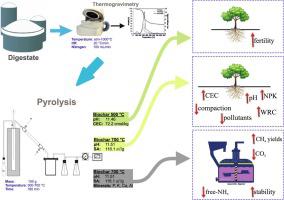Energy Conversion and Management ( IF 10.4 ) Pub Date : 2023-01-10 , DOI: 10.1016/j.enconman.2023.116658 Panagiotis Basinas , Jiří Rusín , Kateřina Chamrádová , Sotiris P. Kaldis

|
An industrial digestate was tested under pyrolysis to validate the influence of various temperatures on the potential of waste to provide biochars capable to improve soil productivity and enhance the efficiency of anaerobic digestion. The thermochemical conversion of digestate and the related kinetics were also examined by thermogravimetry and compared to those of biomass.
Digestate provided greater proportions of biochar (41.3–66.5 %wt.) than biomass (15.5–48.6 %wt.) at all temperatures, although cellulose and hemicellulose were less thermally stable than in the untreated biomass as indicated by the low activation energies of 150–180 kJ/mol and 83.1–88.2 kJ/mol, respectively compared to those of the polysaccharides in biomass. The behaviour of digestate during conversion and the quantity of generated biochar were both unaffected by the heating rate. Biochar yields however decreased from 55 to 41.3 %wt. in the isothermal tests with the increment of pyrolysis temperature from 300 to 700 °C. The soil amelioration ability of digestate was almost unaffected by pyrolysis at temperatures below 400 °C. Biochar produced at 500 °C possessed the greatest potential to improve soil fertility in the long-term due to its high alkalinity (pH 11.46) and modest cation exchange capacity (CEC) (72.2 cmol kg−1). The high-temperature biochar with slightly higher pH (11.51) and significantly larger surface area (116.1 m2/g) was the optimal choice for soil amelioration. Compared to the other biochars, the one produced at the highest temperature was also the best anaerobic digestion agent because of the higher alkalinity (pH 11.51), better minerals content (P, K, Ca, Al) and larger than 100 m2/g surface area, all properties that are desirable for the improvement of stability, methane productivity and mitigation of CO2, H2S and free-NH3 in a digestion system.
中文翻译:

厌氧消化固体副产物的热解:消化物分解的表征和生物炭用作土壤改良剂和厌氧消化添加剂的筛选
在热解条件下对工业沼渣进行了测试,以验证各种温度对废物潜力的影响,以提供能够提高土壤生产力和提高厌氧消化效率的生物炭。沼渣的热化学转化和相关动力学也通过热重分析法进行了检查,并与生物质进行了比较。
在所有温度下,消化物提供的生物炭比例 (41.3–66.5 %wt.) 均高于生物质 (15.5–48.6 %wt.),尽管纤维素和半纤维素的热稳定性低于未处理的生物质,如 150 的低活化能所示–180 kJ/mol 和 83.1–88.2 kJ/mol,分别与生物质中的多糖相比。转化过程中沼渣的行为和生成的生物炭的数量均不受加热速率的影响。然而,生物炭产量从 55% wt 下降到 41.3%wt。在等温试验中,热解温度从 300 增加到 700 °C。在低于 400 °C 的温度下,消化物的土壤改良能力几乎不受热解的影响。-1)。pH值稍高(11.51)、比表面积(116.1 m 2 /g)显着增大的高温生物炭是土壤改良的最佳选择。与其他生物炭相比,在最高温度下产生的生物炭也是最好的厌氧消化剂,因为它具有更高的碱度(pH 11.51)、更好的矿物质含量(P、K、Ca、Al)并且大于 100 m 2 /g表面积、消化系统中提高稳定性、甲烷生产率和减少 CO 2、H 2 S 和游离 NH 3所需的所有特性。



























 京公网安备 11010802027423号
京公网安备 11010802027423号